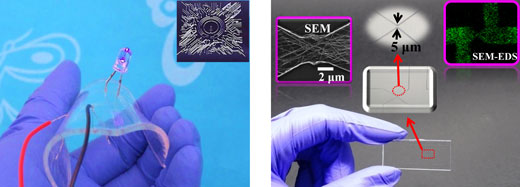| Posted: May 31, 2018 | |
Microfluidics meets silver nanowires: transparent and flexible circuits with ultra precise pattern control |
|
| (Nanowerk Spotlight) Researchers at Dalian University have developed a new process for completely transparent and flexible circuits of any patterns as one wishes. The circuit patterns are created via the well-developed microfluidic technology on transparent and flexible substrates. The conductors are generated by spin coating of silver nanowires along the patterns. The advance stimulates more implications in future electronics. | |
| Future electronic devices are often envisioned as transparent and flexible, e.g. transparent and flexible computers, touch screen panels, mobile phones, and wearable medical devices. Transparent and flexible circuits are essential components in such devices. However, completely transparent and flexible circuits are difficult to achieve due to two major challenges in the field of transparent and flexible circuits: 1) both the conductor and the substrate are transparent; 2) ultra precise pattern control. | |
| A study published in Chemical Communications ("Highly transparent and flexible circuits through patterning silver nanowires into microfluidic channels") demonstrates for the first time that complete flexible and transparent circuits can be fabricated via an operation-friendly protocol, exhibiting excellent transparency, conductivity, stretchability, twistability, ultra precise pattern control, and features for massive production. The study is also highlighted on the back cover of this issue of the journal. | |
| The transparent and flexible circuits are created by coating silver nanowires into microfluidic channels. Microfluidics is a technology that deals with very small volumes (e.g. nanoliters) of fluids. The fluids are contained in the so-called microfluidic channels in a soft and optically transparent material. Both silver particles and silver nanowires are good materials to build transparent and flexible electrodes. However, previous techniques produce circuits that are either lack in pattern control (by nanoparticles) or optically opaque (by nanowires). | |
 |
|
| These images show on the left a shining LED on a transparent and flexible circuit with complex patterns (upper right inset) and on the right a thin circuit (5-µm width) with a scanning electron microscope (SEM, upper left inset) and an SEM-energy dispersive spectrometer (SEM-EDS, upper right inset) image, indicating that the conductors are evenly and continuously distributed through the entire circuit including the narrowest part (5 µm). (click on image to enlarge) | |
| “Our work involves the merits of both microfluidic technology and silver nanowires,” says Dr. Jing Sun, co-corresponding author of a paper on the study and a professor of analytical chemistry at Dalian University. “Silver nanowires are dissolved in non-toxic solvents such as water and ethanol. Then the silver nanowire solution is filled into the microfluidic channels by conventional coating methods. Since the microfluidic channels can be created down to the nanoscale very precisely, the resulted circuits can be very complex and the patterns can be designed as precise as possible.” | |
| “The circuits made by the silver nanowires have high conductivity and transparency. The circuits can also bear repeated bending, twisting, and stretching,” says Wenhui Zhou, a master’s degree student at Dalian University and second author of the paper. | |
| “Furthermore, because the conductive parts of the circuits are in the channels, they are extremely durable, compared with laying the silver nanowires only on the surface,” says Dr. Ming-Fei Lang, a professor of basic medicine at Dalian University and co-corresponding author of the paper. | |
| Adding to the above, the circuits are easy to produce, size scalable, and highly reproducible, all of which are characteristics that make them suitable for mass production. | |
| The researchers have demonstrated a simple application of the circuits as a biosensor for glucose detection. Dalian University has filed a provisional patent on the technique. | |
| “With the synchronous optical, mechanical, and electrical properties, our technique can generate pattern controllable, size scalable, and quality reproducible transparent and flexible circuits. We are glad that our fabrication strategy can contribute to the potential applications in wearable medical equipment and transparent electronic devices,” Dr. Sun says. | |
| The study was done with support from the National Natural Science Foundation of China and Liaoning Province under grants 21505013 and 2015020660, respectively. | |
|
Provided by Dalian University as a Nanowerk exclusive
|
|
|
Become a Spotlight guest author! Join our large and growing group of guest contributors. Have you just published a scientific paper or have other exciting developments to share with the nanotechnology community? Here is how to publish on nanowerk.com. |
|
